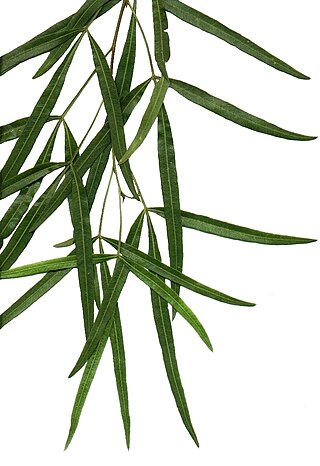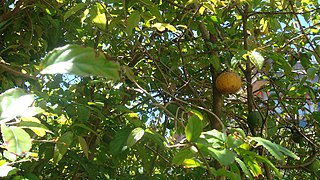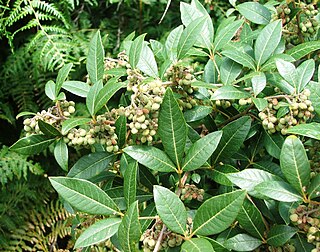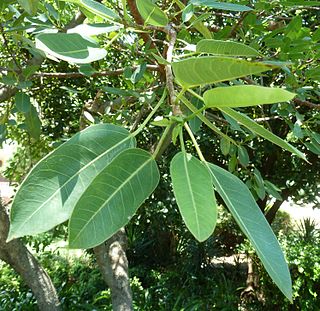In botany, a stipule is an outgrowth typically borne on both sides of the base of a leafstalk. Stipules are considered part of the anatomy of the leaf of a typical flowering plant, although in many species they may be inconspicuous —or sometimes entirely absent, and the leaf is then termed exstipulate. The word stipule was coined by Linnaeus from Latin stipula, straw, stalk.

Kirstenbosch is an important botanical garden nestled at the eastern foot of Table Mountain in Cape Town. The garden is one of 10 National Botanical Gardens covering five of South Africa's six different biomes and administered by the South African National Biodiversity Institute (SANBI). Prior to 1 September 2004, the institute was known as the National Botanical Institute.

Searsia pyroides, previously known as Rhus pyroides, is a species of Searsia, native to southern Africa. This tree occurs throughout the whole of South Africa, a part of Botswana, Zimbabwe and Tanzania and in some areas of Namibia near Windhoek.

Searsia lancea commonly known as karee, is an evergreen, frost hardy, drought resistant tree, which can reach up to 8 metres in height with a 5-metre spread. It is one of the most common trees on the Highveld and in the Bushveld in South Africa, but not found in the Lowveld. In North America, where it is naturalized, it is known as African sumac and willow rhus.

Protea laurifolia, also known as the grey-leaf sugarbush, is a shrub from South Africa. It is native to the Cape Provinces of South Africa.

Burchellia is a monotypic genus of flowering plants in the family Rubiaceae. The genus contains only one species, viz. Burchellia bubalina, which is endemic to southern Africa: the Cape Provinces, KwaZulu-Natal and the Northern Provinces in South Africa, and Eswatini. It is commonly known as wild pomegranate (English) or wildegranaat (Afrikaans).

Strelitzia caudata, commonly known as the mountain strelitzia or wild banana, is a species of banana-like Strelitzia from Africa from the Chimanimani Mountains of Zimbabwe south to Mozambique, the Northern Provinces of South Africa and Eswatini (Swaziland). It was first described in 1946 by Robert Allen Dyer in Flowering Plants of Africa, Volume 25, Plate 997. The specific epithet caudata means "having a tail"; this refers to an appendage of a sepal, which occurs only in this species. It is one of three large banana-like Strelitzia species, all of which are native to southern Africa, the other two being S. alba and S. nicolai.

Oncoba spinosa, the snuff-box tree, fried egg tree or fried-egg flower, is a plant species in the genus Oncoba.

Searsia tomentosa, the real wild currant (English), umhlakoti (Zulu) or korentebos (Afrikaans), is a small, bushy, evergreen tree that occurs in fynbos and coastal shrub in South Africa. It is naturally most common in forest margins.

Searsia angustifolia, the willow karee or smalblaar, is a small, bushy, evergreen tree which is confined to the South Western Cape in South Africa.

Hyphaene petersiana, the real fan palm or makalani palm, is a palm tree native to the subtropical, low-lying regions of south central Africa.

Erythrina zeyheri, commonly known as the ploughbreaker, is a deciduous, geoxylic subshrub and member of the Fabaceae, which is endemic to southern Africa. It grows no more than 60 cm tall and occurs naturally in the higher altitude grasslands of South Africa's central plateau, and that of adjacent Lesotho. They favour deep clay soil in the vicinity of creeks and marshes, and often form colonies. Its specific name commemorates the 19th century botanist, Karl Zeyher.

The Wonderboom is an evergreen fig species that ranges from the KwaZulu-Natal midlands northwards to tropical East Africa. It grows especially on outcrops, rocky hillsides and along cliffs fringing water courses and may rarely grow up to 10 m tall, and acquire a leafy spreading crown.

Marie Prins is a South African botanist.

Vitellariopsis marginata is a species of plant in the family Sapotaceae. It is native to Mozambique, South Africa, and Eswatini.
Osyris daruma is a species of plant in the family Santalaceae.

Excoecaria simii, the forest pepper-seed or forest pepper-seed bush, is a species of flowering plant in the family Euphorbiaceae. It is endemic to South Africa, in forests of KwaZulu-Natal and Eastern Cape.

Tonteldoos is a village in the province of Limpopo, South Africa. It is located southeast of Roossenekal and 20 km northwest of Dullstroom, between the Steenkampsberg and Mapochsberg mountains. It is part of the Mapoch land seized by poor settlers in 1883 after the Mapoch War against King Nyabêla. Each veteran of the war was granted 8 morgens of the land, while the rest is reserved for communal pasture.

Brian John Huntley is a retired professor and conservation scientist from South Africa, best known for developing and transforming African national parks. He was involved in expanding the National Botanical Institute to become an authoritative repository on South African flora and fauna. As an independent expert, he was a consultant for agencies and international organizations, including the United Nations, with regard to nature conservation. He himself took part in multiple conservation projects around Africa.

Ben-Erik van Wyk FAAS is a South African professor of indigenous botany and traditional African medicine at the University of Johannesburg.





















